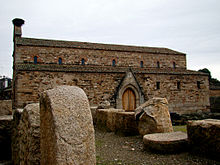Idanha-a-Velha
| Idanha-a-Velha | ||||||
|---|---|---|---|---|---|---|
|
||||||
| Basic data | ||||||
| Region : | Centro | |||||
| Sub-region : | Viseu Dão-Lafoes | |||||
| District : | Castelo Branco | |||||
| Concelho : | Idanha-a-Nova | |||||
| Freguesia : | União das Freguesias de Monsanto e Idanha-a-Velha | |||||
| Coordinates : | 40 ° 0 ′ N , 7 ° 9 ′ W | |||||
| politics | ||||||
| Website: | http://www.cm-idanhanova.pt/ | |||||

Idanha-a-Velha is a place and a former municipality ( freguesia ) in the Portuguese district of Idanha-a-Nova . The community had 63 inhabitants (as of June 30, 2011). The place belongs to the twelve historical villages, the Aldeias Históricas .
history
The place was founded in the first century BC by the Romans as Civitas Igaeditanorum . Under the Suebi it was called Egitânia and in 534 it became a diocese . 14 years later the place came to the Visigoth Empire until it was conquered by the Arabs in 715 . The place, which was now called Exitânia and then Idania , became the administrative seat of the Moors and was on the route from Mérida to Guarda . At the end of the 9th century, the place was ruled by the Moorish rebel leaders Saʿdūn as-Surunbāqī and Ibn Marwan . During the Reconquista , Idanha was conquered several times before Portugal's first king, D.Afonso Henriques , conquered the place in 1165 and handed it over to Gualdim Pais . One condition was the construction of two new castles to defend the bishopric of Egitania, which Pais fulfilled with the founding of Monsanto and Idanha-a-Nova . Since 1199 Idanha was no longer a bishopric and from then on belonged to the Diocese of Guarda.
In 1229 Idanha received city rights ( Foral ) by King Sancho II. After another Arab invasion and destruction in 1240, the place was handed over to the Knights Templar and repopulated. In 1510 King Manuel I renewed Idanha's city rights, and the cathedral was expanded and rebuilt. The place Idanha-a-Nova (English: New Idanha), founded not far in 1187, gained increasing importance, while the place now called Idanha-a-Velha (German: Old Idanha) lost its inhabitants. Until 1758 it kept the status of a cidade (town) , with progressive loss of importance, only to lose the status of a vila (small town) in the 19th century . In 1819 Idanha-a-Velha Alcafozes was assigned, and since 1935 it has belonged to Idanha-a-Nova County.
The archaeological work that began in the 1950s was discontinued in the 1970s. In 1981, the Nobel Prize for Literature Laureate José Saramago regretted the poor condition of the numerous historical buildings and their remains in the place during his trip described in the book Viagem a Portugal (German: Reise nach Portugal, German title: Die Portugiesische Reise).
In 1994 the place was recognized as an Aldeia Histórica (German: historical village) to be promoted . It is part of the Aldeias Históricas de Portugal , a government initiative to preserve historic villages in the region. Since then, the buildings from different eras have been restored, and the place has received further funding related to the program.
On September 29, 2013, the parishes of Idanha-a-Velha and Monsanto were merged to form the new parish União das Freguesias de Monsanto e Idanha-a-Velha .
Culture and sights
Among the 14 listed buildings of the place are a well-preserved Roman bridge that since the first century repeatedly rebuilt city walls with tower, which repeatedly extended since 559 and changed Cathedral, and the manor house Solar da Família Marrocos from the early 20th century.
The 19th-century Lagar das Varas building, which is also a listed building , which houses the olive oil press facilities, houses the tourist information office and an ethnographic museum.
Various, thematically sorted hiking trails run through the municipality. Some old buildings are run as guest houses for the rural tourism. Traditional bread is baked in the village's public oven.
In addition to religious festivals and occasional medieval markets and festivals, the Boom Festival takes place in the area around the town every year in August . The climate-neutral festival offers music events as well as workshops , exhibitions, installations and the like. a. It was included in its United Nations Music & Environmental Initiative project by the United Nations Environment Program .
Web links
- The website of the municipality at the district
- Idanha-a-Velha at the PortugalVirtual tourism portal
Individual evidence
- ↑ www.ine.pt - indicator resident population by place of residence and sex; Decennial in the database of the Instituto Nacional de Estatística
- ↑ Winfried Kreutzer : History of Portugal , page 34 . Reclam-Verlag, Ditzingen 2013
- ^ João Fonseca: Dicionário do Nome das Terras. 2nd edition, Casa das Letras, Cruz Quebrada 2007, page 133 ( ISBN 978-972-46-1730-5 )
- ↑ Susana Falhas, Henrique Almeida: Historic villages of Portugal. Olho de Turista, Mêda 2010, page 280 ( ISBN 978-989-967430-1 )
- ^ Margarida Magalhães Ramalho: Aldeias Históricas. 1st edition, Edições Inapa, Lisbon 2006, page 71ff ( ISBN 972-797-097-4 )
- ^ José Saramago: Viagem a Portugal. 17th edition, Editorial Caminho , Lisbon 1998, page 140 ( ISBN 972-21-0047-5 )
- ^ Publication of the administrative reorganization in the Diário da República gazette of January 28, 2013, accessed on October 1, 2014
- ↑ www.monumentos.pt , accessed on November 10, 2012
- ↑ ditto
- ↑ ditto
- ↑ ditto
- ↑ ditto




